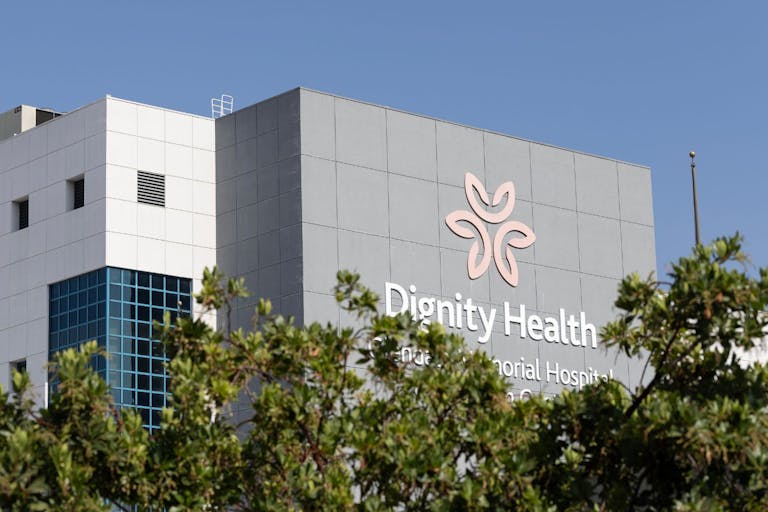
China to tax contraceptives in desperate effort to boost birth rates
Angeline Tan
·
California woman says Catholic hospital denied emergency abortion
A California woman has filed a lawsuit against two Catholic hospitals operating under the umbrella of Dignity Health, claiming that doctors failed twice to give her appropriate care — what she claims would have been a medically necessary induced abortion.
Rachel Harrison's water broke at 17 weeks during a pregnancy in 2024, and during another pregnancy in 2025.
Each time, she went to a Dignity Health Catholic hospital, but was reportedly sent away after receiving a diagnosis of preterm premature rupture of membranes (PPROM).
Harrison's lawsuit alleges that the Catholic hospitals refused to give her an abortion because of religious reasons.
The standard of care for PPROM is to attempt to prevent labor, watch for signs of infection, administer antibiotics, and provide medications to protect the baby.
If labor cannot be stopped or the woman shows signs of an infection, the baby would need to be delivered. A preterm delivery with the intent to save the mother (not with the intent to kill the child) is not an induced abortion.
Rachel Harrison and her partner, Marcell Johnson, recently filed suit against Dignity Health, doing business as Mercy San Juan Medical Center and Mercy General Hospital. The complaint states that doctors at both hospitals failed to commit an emergency abortion on two separate occasions during two separate pregnancies, during which Harrison suffered PPROM at 17 weeks.
PPROM is the premature rupture of membranes (PROM) before 37 weeks of pregnancy. In September 2024, Harrison's water broke at 17 weeks and she rushed to Mercy San Juan Medical Center. There, she was told that their baby was not going to survive because there was "no amniotic fluid," according to the lawsuit. At 17 weeks, the baby was too young to survive a preterm delivery, but still had a heartbeat.
The lawsuit states:
[N]o one at Mercy San Juan presented any emergency abortion procedures to her as an option. Instead, Rachel was told that because of the hospital’s Catholic affiliation, there was nothing more the hospital could do for her....
To be clear, Mercy San Juan could have performed an emergency procedure to safely complete Rachel’s miscarriage and reduce the risk of the serious complications associated with Previable PPROM....
Yet, they chose not to do so for a brazenly nonmedical reason: Rachel’s ultrasound detected a faint fetal heartbeat, and performing an emergency abortion procedure with a detectable fetal heartbeat violates the hospital’s religious directives.
Harrison was reportedly sent home, and the following day, she underwent a D&C procedure at Kaiser Hospital.
Months later and pregnant again, Harrison suffered PPROM for the second time at 17 weeks. This time, Harrison went to Mercy General Hospital. She was advised to go to Kaiser for treatment or return home to wait to miscarry.
"And again, because a fetal heartbeat was still detectable, Rachel was told that there was nothing more that the hospital could do for her," the complaint says.
Harrison went to Kaiser Morse. Because there was still a fetal heartbeat, Harrison was told she could choose one of three options: (1) take a pill to abort the baby; (2) undergo a D&C abortion procedure; or (3) be transferred to another Kaiser hospital, Kaiser Permanente Roseville Medical Center, which is equipped with a labor and delivery unit, to undergo expectant management.
With this final option, Harrison would be immediately admitted and monitored for the purpose of continuing the pregnancy until 22 weeks, the age of viability.
Harrison "chose to go to Kaiser Roseville" with "the hope that her baby would survive.” She chose expectant management, not abortion.
Unfortunately, by the time she arrived at Kaiser Roseville, her baby no longer had a heartbeat. She was able to deliver her stillborn baby; however, the lawsuit claims she required a D&E for retained placenta and suffered from postpartum hemorrhage and an infection that developed into sepsis. She required a blood transfusion and IV antibiotics.
Harrison's lawsuit argues that Dignity Health requires its hospitals to "conform to the Ethical and Religious Directives for Catholic Health Services (the 'ERDs')." The suit also claims:
The ERDs place religiously motivated restrictions on the type of medical care provided at Dignity Health hospitals. Those restrictions compromised Rachel’s care and caused her to suffer the agony of being rejected from an emergency room in the middle of a high-risk pregnancy loss and the physical and mental trauma of undergoing life-threatening complications after being denied emergency medical care.
Thus, while publicly touting their hospitals’ qualifications as reliable emergency services centers, Dignity Health prioritized its own religious directives over the best interests of Rachel’s health and well-being.
The lawsuit argues that both hospitals put Harrison's life at risk by not carrying out abortions because of religious reasons.
But according to multiple medical sources, intentional and direct killing by induced abortion is not the standard of care for PPROM.

The lawsuit states that the "Society for Maternal-Fetal Medicine and the American College of Obstetricians and Gynecologists advise doctors to always offer abortions" in cases of PPROM.
This is unsurprising, because these organizations are also abortion advocacy groups. While they can make recommendations, state medical boards, along with national groups such as the Agency for Healthcare Research and Quality (AHRQ), set the standards based on evidence from medical experts and organizations. ACOG and SMFM can influence the standards by giving their opinions to the groups that regulate medicine, but they don't set the standards.
A practice advisory released by ACOG this summer for PPROM states that new research indicates higher rates of maternal morbidity (sickness) in women with PPROM who were cared for with expectant management, compared to those whose babies were delivered early or intentionally killed by abortion. It states:
In Practice Bulletin 217, it is currently recommended that patients with previable and periviable PROM be counseled regarding the risks and benefits of both expectant management and immediate delivery. Both options should be offered. Immediate delivery may involve termination of the pregnancy through induction of labor or by dilation and evacuation.

The advisory states that 43% of patients up to 22 weeks pregnant experienced maternal morbidity (sickness), including clinical chorioamnionitis (infection) and hemorrhage when undergoing expectant management for PPROM.
Article continues below
Dear Reader,
Have you ever wanted to share the miracle of human development with little ones? Live Action is proud to present the "Baby Olivia" board book, which presents the content of Live Action's "Baby Olivia" fetal development video in a fun, new format. It's perfect for helping little minds understand the complex and beautiful process of human development in the womb.
Receive our brand new Baby Olivia board book when you give a one-time gift of $30 or more (or begin a new monthly gift of $15 or more).
A separate study of patients with PPROM between 14 weeks and 23 weeks, six days compared outcomes of women who underwent expectant management, induction of labor, or abortion. Higher rates of infection, postpartum hemorrhage, and sepsis in patients who underwent expectant management were found to not be of "statistical significance."
The women didn't die, but because of the higher risk of infection with expectant management, ACOG claims women must be given induced abortion (intentional killing of the preborn child) as an option for PPROM, even after viability.
In addition, ACOG categorizes abortion as a form of delivery, saying, "Immediate delivery may involve termination of the pregnancy through induction of labor or by dilation and evacuation."
And that's where the issue lies. During a dilation and evacuation the baby is dismembered and her head crushed as she is pulled, limb by limb, out of the uterus.
Killing the baby is not necessary in order to deliver the baby.
OBGYNs who do not advocate for abortion have made this clear.
According to the evidence-based guidelines established by the American Association of Pro-Life OBGYNs, PPROM does not require the preborn child to be killed when delivery is required. Here's how the group explains treatment for PPROM after infection has begun:
Separating the mother from the placenta is an act of source control in the treatment of intraamniotic infection or sepsis. It is the separation of the mother from the placenta that saves her life, regardless of whether the fetus is alive at the time of separation. So, killing her fetus (intentional feticide) is not the life-saving treatment.
The death of her child is not the action which saves her life, but rather a tragic, unavoidable consequence. If we could save her child, we would do so. This concept is well illustrated by the treatment of chorioamnionitis at or near term. The treatment is delivery, not intentional feticide, in this circumstance.
Induced abortion — the act of directly and intentionally causing the death of a preborn child — is not the typical or immediate standard of care for PPROM, and it isn't just pro-life OBGYNs who know this.
According to the Fetal Care Center (September 2024), "Regardless of when your water breaks, the standard of care in the U.S. is to admit you to the hospital until your baby is born. 'You might need to be transported to a higher-level facility,' says Dr. [David] Berry. Since most PPROM cases result in premature birth, you'll need to be at a hospital equipped to care for extremely premature babies."
It also states that "the goal is to keep you and baby free of infection and delay delivery as long as possible to allow for the maximum amount of development." While the average length of time from rupture of membranes to delivery in PPROM is seven days, Dr. Berry has had patients "stay for two or three months."
According to the Cleveland Clinic (in an entry last reviewed on 12/22/2022), in the event of PPROM, “Your provider will keep you in the hospital on bed rest and attempt to prolong the pregnancy.” Treatments may include steroids to develop the baby’s lungs, antibiotics to prevent infection and prolong the pregnancy, medication to stop labor, and magnesium sulfate to help the baby’s brain. Doctors should also monitor the mother for signs of infection.
Likewise, the Children's Hospital of Philadelphia explained that expectant management, antibiotics, medications to prevent preterm labor, and medications to help the baby's lungs are standard care for PPROM. "Women with PPROM," it explained, "usually deliver at 34 weeks if stable. If there are signs of abruption, chorioamnionitis, or fetal compromise, then early delivery would be necessary" (emphasis added).
Harrison should have been admitted to the hospital and monitored for infection, inducing labor or performing a c-section if the pregnancy emergently needed to end.
However, according to footnotes in Harrison's lawsuit, "On information and belief, Dignity Health does not even accept patients in its Labor and Delivery unit prior to 20 weeks because they are deemed not viable for delivery. It directs patients experiencing pregnancy complications prior to 20 weeks to the Emergency Department."
This explains why Dignity Health did not admit Harrison, but it doesn't explain why it didn't transfer her to a hospital prepared to care for her and her babies. They deserved high-quality, compassionate care, not to be sent home with the risks of infection and labor brewing, and certainly not to be told abortion was the option.
What's more is Harrison's babies may have have a small chance of survival that was stolen from them.
Suzy Mack suffered PPROM at 17 weeks, but under her doctor's care, she delivered her baby safely at 28 weeks. Jillian suffered PPROM at 17.5 weeks, but carried her son safely to 32 weeks.
PPROM can end in tragedy, but the standard of care has never been induced abortion with the intent to kill the child. Pro-abortion groups advocate for abortion; therefore, they must convince Americans that induced abortion (intentional killing) is health care. Admitting that killing preborn children is not medically necessary would expose the truth — that induced abortion as a whole is completely unnecessary.
Live Action News is pro-life news and commentary from a pro-life perspective.
Contact editor@liveaction.org for questions, corrections, or if you are seeking permission to reprint any Live Action News content.
Guest Articles: To submit a guest article to Live Action News, email editor@liveaction.org with an attached Word document of 800-1000 words. Please also attach any photos relevant to your submission if applicable. If your submission is accepted for publication, you will be notified within three weeks. Guest articles are not compensated (see our Open License Agreement). Thank you for your interest in Live Action News!

Angeline Tan
·
Opinion
Nancy Flanders
·
Investigative
Carole Novielli
·
International
Cassy Cooke
·
Analysis
Nancy Flanders
·
Analysis
Cassy Cooke
·
Activism
Nancy Flanders
·
Opinion
Nancy Flanders
·
Investigative
Nancy Flanders
·
Analysis
Nancy Flanders
·
Politics
Nancy Flanders
·